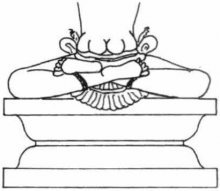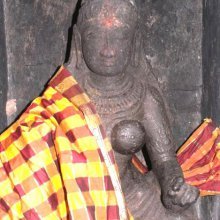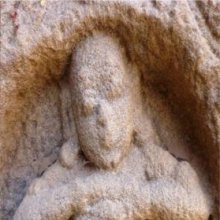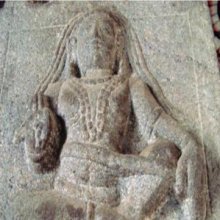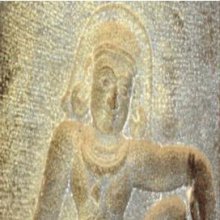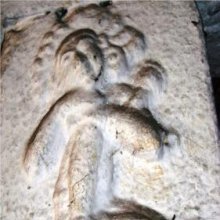Padmasana, Padma-asana, Padmāsana: 36 definitions
Introduction:
Padmasana means something in Buddhism, Pali, Hinduism, Sanskrit, Jainism, Prakrit, the history of ancient India, Marathi, Hindi. If you want to know the exact meaning, history, etymology or English translation of this term then check out the descriptions on this page. Add your comment or reference to a book if you want to contribute to this summary article.
Alternative spellings of this word include Padmasan.
Images (photo gallery)
(+22 more images available)
In Hinduism
Shilpashastra (iconography)
Source: Google Books: The Book of Hindu Imagery: Gods, Manifestations and Their MeaningPadmasana (padma-asana)—The lotus position. The feet are crossed, the toes are placed in the groin. This is the position of deep meditation.
Source: Google Books: Elements of Hindu iconographyIn the Padmāsana (पद्मासन) the two legs are kept crossed so that the feet are brought to rest upon the thighs. When used as a pītha (seat or pedestal), this Āsana should be used as the seat for the image during the conduct of worship, according to the Suprabhedāgama. According to the Candrajñānāgama, the seat is of a circular shape. The height of the Padmāsana consists of sixteen parts, of which two form the thickness of the lowest layer, five make up the lower lotus, two the intervening neck, and four the pper lotus and two more the uppermost layer.
Padmāsana should always be circular or oval, but never rectangular. In the absence of authoritative information as to its length and breadth, it is left to the sculptor to choose them so as to suit his purpose.
Source: Red Zambala: Hindu Icons and Symbols | IntroductionPadmāsana (पद्मासन).—Both legs crossed in Padmāsana (lotus posture) indicate a state of transcendence with a potential for manifestation.
Source: Shodhganga: The significance of the mūla-beras (śilpa)Padmāsana (पद्मासन) or Kamalāsana refers to a type of Āsana (sitting poses), according to Ganapati Sthapati in his text Ciṟpa Cennūl, as defined according to texts dealing with śilpa (arts and crafs), known as śilpaśāstras.—An image sitting cross-legged, with the feet facing upwards and resting on the thighs, and the body held erect, is said to be in padmāsana or kamalāsana. This posture is also known as paryaṅkāsana or vajrāsana in the Buddhist tradition. When one leg is folded, with the other foot resting on its thigh, it is called ardhapadmāsana.
According to T. A. G. Rao in his text ‘Elements of Hindu Iconography’, padmāsana is a circular seat and should be used as the seat for the image when during the conduct of worship. Brahma-sthānaka is the posture to sit keeping one leg on the knee of the second leg and the second leg on the knee of the first leg. This posture is popularly known as padmāsana in iconography as a sitting posture. Goddesses Lakṣmī, Sarasvatī and Amman are found to be seated in padmāsana or ardha-padmāsana postures.
Source: Shodhganga: Vaisnava Agamas And Visnu ImagesPadmāsana (पद्मासन) refers to one of the various posture (āsanas) defined in treatises such as the Pāñcarātra, Pādmasaṃhitā and Vaikhānasa-āgamas, extensively dealing with the technical features of temple art, iconography and architecture in Vaishnavism.—Padmāsana is a sitting position in which the legs are crossed with the soles of the both feet turned upward and resting on the opposite thighs. Śrī in the form of Yogalakṣmī or Śrīvatsa, is described in this posture, according to the Vaiṣṇava Āgamas. This posture is applicable for Śrī installed in the parivāra-ālaya in the Viṣṇu temples. This denotes deep meditation and concentration. This pose is prescribed for the icons of subordinate or accompanying divinities to be depicted in worshipping attitude. In Ardhapadmāsana posture, the folded legs are placed one above the other.

Shilpashastra (शिल्पशास्त्र, śilpaśāstra) represents the ancient Indian science (shastra) of creative arts (shilpa) such as sculpture, iconography and painting. Closely related to Vastushastra (architecture), they often share the same literature.
Purana and Itihasa (epic history)
Source: Cologne Digital Sanskrit Dictionaries: The Purana IndexPadmāsana (पद्मासन).—A kind of āsana in yoga, once practised by Paraśurāma; of Kapila.*
- * Brahmāṇḍa-purāṇa III. 24. 16; 53. 17.

The Purana (पुराण, purāṇas) refers to Sanskrit literature preserving ancient India’s vast cultural history, including historical legends, religious ceremonies, various arts and sciences. The eighteen mahapuranas total over 400,000 shlokas (metrical couplets) and date to at least several centuries BCE.
Shaivism (Shaiva philosophy)
Source: Wisdom Library: ŚaivismPadmāsana (पद्मासन) is one of five pedestals that makes up the Śivāsana, unto which Śiva is installed and invoked during the ritualistic process of śivārcana, according to the Sakalāgamasāra-saṃgraha. In the process of invocation (āvāhana) Lord Śiva is contemplated as seated on Yogāsana: “in the process of offering of flowers (arcana) he is meditated upon as seated on padmāsana”. This particular āsana is associated with the shape of a circle and is connected with the element Air.
Source: Brill: Śaivism and the Tantric TraditionsPadmāsana (पद्मासन) refers to a “lotus seat”, according to verse 4.595-596b of the Brahmayāmala-tantra (or Picumata), an early 7th century Śaiva text consisting of twelve-thousand verses.—Accordingly, “The best of Sādhakas should install the supreme Śakti [hāṃ] on the entire body, without face, eye, or limb mantras, devoid of a lotus seat; (padmāsana-vihīnā) one should [also] envision her in each lotus, conjoining/possessing the lotus garlands”.
Source: SOAS University of London: Protective Rites in the Netra TantraPadmāsana (पद्मासन) refers to the “lotus seat” and is associated with Buddha, according to the Netratantra of Kṣemarāja: a Śaiva text from the 9th century in which Śiva (Bhairava) teaches Pārvatī topics such as metaphysics, cosmology, and soteriology.—Accordingly, [verse 13.29-36, while describing the appearance and worship of Rudra]—“The Buddha, the great Yogi, sits on a lotus (padmāsana-gata), [head] bent, listening, and wearing mendicant's rags. [He possesses] beautiful lotus eyes, has a lotus-shaped mark, and is fixed with a jewel. [He is] established in the world, positioned in samādhi, his hands [making the] wish-granting and protection [mudrās]. Deva holds a rudrākṣa and a lotus. Thus, [the Mantrin] should worship and meditate upon Buddha, [who] grants the fruits of mokṣa to women”.

Shaiva (शैव, śaiva) or Shaivism (śaivism) represents a tradition of Hinduism worshiping Shiva as the supreme being. Closely related to Shaktism, Shaiva literature includes a range of scriptures, including Tantras, while the root of this tradition may be traced back to the ancient Vedas.
Yoga (school of philosophy)
Source: Google Books: The Hatha Yoga PradipikaPadmāsana (पद्मासन) refers to an āsana (posture) taught by Śiva. It is one of the first four out of 84 total, thus one of the most essential, according to Haṭhayogapradīpikā I.46-51.—Accordingly, “Place the right foot on the left thigh and the left foot on the right thigh, and grasp the toes with the hands crossed over the back. Press the chin against the chest and gaze on the tip of the nose. This is called the padmāsana, the destroyer of the diseases of the yamīs”.
Also, “Place the feet on the thighs, with the soles upwards, and place the hands on the thighs, with the palms upwards. Gaze on the tip of the nose, keeping the tongue pressed against the root of the teeth of the upper jaw, and the chin against the chest, and raise the air up slowly, i.e., pull the apāna-vāyū gently upwards. This is called the padmāsana, the destroyer of all diseases. It is difficult of attainment by everybody, but can be learnt by intelligent people in this world”.
Also, “Having kept both the hands together in the lap, performing the padmāsana firmly, keeping the chin Fixed to the chest and contemplating on Him in the mind, by drawing the apāna-vāyū up (performing mūla-bandha) and pushing down the air after inhaling it, joining thus the prāṇaand apāna in the navel, one gets the highest intelligence by awakening the Śakti (kuṇḍalinī) thus. The Yogī who, sitting with padmāsana, can control breathing, there is no doubt, is free from bondage”.
The 15th-century Haṭhayogapradīpikā by Svātmārāma is one of the oldest extant texts dealing with haṭhayoga: an ancient form of meditation founded by Matsyendranātha. The first chapter of this book describes various āsanas (e.g., padma-āsana).
Source: archive.org: Yoga Tradition of the Mysore PalacePadmāsana (पद्मासन) is a type of standing posture (āsana), according to verse 79 of the Śrītattvanidhi.—Accordingly, “Put the right leg over the left thigh and the left leg over the right thigh. Cross the hands inversely and take hold of the big toe firmly. Place the chin firmly on the chest and look at the tip of the nose. This is padmāsana, the lotus”.
The 19th-century Śrītattvanidhi is a sanskrit treatise describing 80 primary āsanas, or ‘posture’ (e.g., padma-āsana) and several additional ones.
Note: this āsana is listed in many places.
Source: archive.org: Gheranda SamhitaPadmāsana (पद्मासन) is one of the thirty-two āsanas (postures) taught in the second chapter of the Gheraṇḍasaṃhitā: “placing the right foot on the left thigh and likewise the left on the right thigh; crossing the hands behind the back to hold the two big toes; placing the chin on the chest, one should turn the gaze to the tipof the nose. This is called Padmāsana which is capable of destroying all diseases”.
Padmāsana is one of the selected 32 postures amongs 8,400,000 total mentioned by Śiva, according to Gheraṇḍasaṃhitā 2.1-2, “In all, there are as many Āsanas as species of animals. Eighty-four lacs of them are mentioned by Śiva. Out of them, 84 are regarded as important and among these 84, again 32 are good (enough) in this world of mortal beings”.
The 17th-century Gheraṇḍasaṃhitā (mentioning padma-āsana) is one of the three classic texts of Haṭha-yoga: a major branch of Yoga, sharing similarities with the Yoga system taught by Patañjali, though claiming its own mythical founder known as Matsyendranātha. This gheraṇḍa-saṃhitā is an encyclopedic Sanskrit treatise describing thirty two such āsanas.
Source: ORA: Amanaska (king of all yogas): A Critical Edition and Annotated Translation by Jason BirchPadmāsana (पद्मासन) refers to the “lotus pose”, according to the Dattātreyayogaśāstra verse 35-38ab.—Accordingly, while describing the lotus pose (padmāsana): “Having carefully placed the upturned feet on the thighs and the upturned hands in between the thighs, [the Yogin] should fix the eyes on the tip of the nose. Having lifted the uvula with the tongue; having fixed the chin on the chest and having drawn in the breath slowly according to his capacity, he should fill [the region of] the stomach. After that, he should exhale the breath slowly according to his capacity. This is said to be padmāsana, which destroys all diseases”.

Yoga is originally considered a branch of Hindu philosophy (astika), but both ancient and modern Yoga combine the physical, mental and spiritual. Yoga teaches various physical techniques also known as āsanas (postures), used for various purposes (eg., meditation, contemplation, relaxation).
Shaktism (Shakta philosophy)
Source: Google Books: ManthanabhairavatantramPadmāsana (पद्मासन) refers to the “the lotus posture”, according to the Manthānabhairavatantra, a vast sprawling work that belongs to a corpus of Tantric texts concerned with the worship of the goddess Kubjikā.—Accordingly, “[...] His body is adorned on the left (by his consort) and he is adorned with a garland of wild flowers. He wears earrings made of snakes and his sacred thread is Vāsuki. The Lord is adorned with tinkling anklets and sits on a ghost in the lotus posture [i.e., preta-padmāsana]. He is adorned with the five insignia and a garland of severed heads that hangs from his neck up to his feet. He dances with the bliss of wine and is accompanied by heroes and Bhairavas. Sixty-four Yoginīs and great mothers encompass him. He is endowed with sixty-four energies and adorned with ghosts and demons. O Śambhu, Bhairava is said to have as his seat (āsana) the Supreme Goddess”.
Source: academia.edu: The Śāradātilakatantra on YogaPadmāsana (पद्मासन) refers to one of the five āsanas (postures) explained by Lakṣmaṇadeśika in his 11th-century Śaradātilaka verse 25.10cd–11.—“Having placed the soles of both feet properly on both thighs ininverted order, [the Yogin] should then grasp both big toes with both hands. The lotus posture (padmāsana), which is dear to Yogins, is prescribed thus”.
Source: Brill: Śaivism and the Tantric Traditions (shaktism)Padmāsana (पद्मासन) refers to “sitting upon a lotus”, according to the King Vatsarāja’s Pūjāstuti called the Kāmasiddhistuti (also Vāmakeśvarīstuti), guiding one through the worship of the Goddess Nityā.—Accordingly, “[...] I worship the three-eyed sharp-natured Kṣetreśa. His body is black, he has destroyed his adversaries, he carries a skull-bowl and a spear, [but] he is compassionate. I resort to Śaṅkhanidhi and Padmanidhi, who who sit upon a conch and lotus (padmāsana) [respectively] as their seats. They are patient, bear the gestures of generosity and protection in their hands, and bring about everyone’s dreams. [...]

Shakta (शाक्त, śākta) or Shaktism (śāktism) represents a tradition of Hinduism where the Goddess (Devi) is revered and worshipped. Shakta literature includes a range of scriptures, including various Agamas and Tantras, although its roots may be traced back to the Vedas.
Pancaratra (worship of Nārāyaṇa)
Source: archive.org: Catalogue of Pancaratra Agama TextsPadmāsana (पद्मासन) (=abjāsana) refers to one of the Mudrās mentioned in the eighteenth chapter of the Agastyasaṃhitā (agastya-suīkṣṇa-saṃvāda edition), an ancient Pāñcarātra Āgama text dealing with the worship of Rāma, Sītā, Lakṣmaṇa and Hanumān.—[Cf. the chapter pūjāsādhanalakṣaṇa].—[...] One should offer pūjā with devotion [bhakti] and orderliness [saṃkalpa]. [...] Postures [āsana] to be assumed during worship are then discussed—with descriptions of the following: [e.g., padmāsana]. There are many others, the text adds, any one of which can be selected for the repetition of God’s names and for other pious activities [japādi].

Pancaratra (पाञ्चरात्र, pāñcarātra) represents a tradition of Hinduism where Narayana is revered and worshipped. Closeley related to Vaishnavism, the Pancaratra literature includes various Agamas and tantras incorporating many Vaishnava philosophies.
In Buddhism
Mahayana (major branch of Buddhism)
Source: Wisdom Library: Maha Prajnaparamita SastraPadmāsana (पद्मासन).—The Buddha should be visualized as seated in padmāsana, “a position in which the legs are tightly folded with the soles of the feet turned upwards”. This lotus posture had always been utilized by the yogins of India and is still used by the sādhus.

Mahayana (महायान, mahāyāna) is a major branch of Buddhism focusing on the path of a Bodhisattva (spiritual aspirants/ enlightened beings). Extant literature is vast and primarely composed in the Sanskrit language. There are many sūtras of which some of the earliest are the various Prajñāpāramitā sūtras.
Tibetan Buddhism (Vajrayana or tantric Buddhism)
Source: Brill: Śaivism and the Tantric Traditions (tantric Buddhism)Padmāsana (पद्मासन) refers to a “lotus throne”, according to the Nāmamantrārthāvalokinī by Vilāsavajra, which is a commentary on the Nāmasaṃgīti.—Accordingly, [while describing Mañjuśrī-jñānasattva]—“[Next] he should visualise himself as the fortunate one, the gnosis-being [Mañjuśrī], born from the syllable a situated in the middle of that [wisdom-] wheel [situated in the heart of the Ādibuddha]. He has six faces, is radiant like the autumn moon, with the best of sapphires in his beautiful hair, with a halo that has the brilliance of the orb of the newly risen sun, with all the Tathāgatas as [head-]ornaments, immersed in meditative concentration, seated on a variagated lotus throne (vicitra-padmāsana-upaviṣṭa), in tranquil mood, with a pair of books of the Prajñāpāramitā above blue lotuses held in his two hands”.

Tibetan Buddhism includes schools such as Nyingma, Kadampa, Kagyu and Gelug. Their primary canon of literature is divided in two broad categories: The Kangyur, which consists of Buddha’s words, and the Tengyur, which includes commentaries from various sources. Esotericism and tantra techniques (vajrayāna) are collected indepently.
In Jainism
General definition (in Jainism)
Source: archive.org: The Jaina IconographyPadmāsana (पद्मासन) is another name for Paryaṅkāsana which refers to one of the various āsanas (postures) commonly depcited in Jain iconography.—Glossed as Padmāsana, which, in the Jaina Yogic texts, is described as a posture in which the Jaina or any devotee squats on a seat with legs folded, the right leg being on the left thigh and the left leg on the right thigh, while the eyes are fixed upon the tip of the nose. The position of the arms varies. There is a religious prescription to the effect that the image of Mahāvīra, Ṛṣabhanātha and Neminātha should be constructed in this posture or Āsana. The extant sculptures of the Tīrthaṃkaras mentioned do not always support the injunction.
Source: archive.org: TrisastisalakapurusacaritraPadmāsana (पद्मासन) or simply Padma is the name of a posture (āsana), according to chapter 2.1 [ajitanātha-caritra] of Hemacandra’s 11th century Triṣaṣṭiśalākāpuruṣacaritra: an ancient Sanskrit epic poem narrating the history and legends of sixty-three illustrious persons in Jainism.
Accordingly, “the elephant of kings (i.e., Vimalavāhana) dismounted from the elephant’s shoulder and entered the garden, like a lion a mountain-cave. [...] He saw monks there, too, some in the [viz., padmāsana-posture, ...] some engaged in kāyotsarga, and some in ukṣa-posture, indifferent to the body, who had carried out their vows in the midst of numerous attacks, like soldiers in battles, victorious over internal enemies, enduring trials, powerful from penance and meditation [...] The King, with devotion sprouted in the guise of horripilation, as it were, approached Ācārya Arindama and paid homage to him”.
Source: Encyclopedia of Jainism: Tattvartha Sutra 3: The Lower and middle worldsPadmāsana (पद्मासन) or Padmāsanariddhi refers to the “powers to walk over flames of fire” and, classified under ākāśagāmini-ṛddhi (sky-faring powers), represents sub-type of extraordinary activity (kriyā-ṛddhi), which itself is a subclass of the eight ṛddhis (extraordinary powers). These powers can be obtained by the Ārya (civilized people) in order to produce worldly miracles. The Āryas represent one of the two classes of human beings according to the 2nd-century Tattvārthasūtra 3.46, the other being Mleccha (barbarians).
What is meant by extraordinary power to moving in the sky in lotus posture (padmāsana-riddhi)? It is the extraordinary power by which its owner moves in the space even though he is meditating in lotus posture.

Jainism is an Indian religion of Dharma whose doctrine revolves around harmlessness (ahimsa) towards every living being. The two major branches (Digambara and Svetambara) of Jainism stimulate self-control (or, shramana, ‘self-reliance’) and spiritual development through a path of peace for the soul to progess to the ultimate goal.
India history and geography
Source: Cologne Digital Sanskrit Dictionaries: Indian Epigraphical GlossaryPadm-āsana.—(IA 18), used to indicate ‘the sun’; cf. padma- sadman. Note: padm-āsana is defined in the “Indian epigraphical glossary” as it can be found on ancient inscriptions commonly written in Sanskrit, Prakrit or Dravidian languages.

The history of India traces the identification of countries, villages, towns and other regions of India, as well as mythology, zoology, royal dynasties, rulers, tribes, local festivities and traditions and regional languages. Ancient India enjoyed religious freedom and encourages the path of Dharma, a concept common to Buddhism, Hinduism, and Jainism.
Languages of India and abroad
Marathi-English dictionary
Source: DDSA: The Molesworth Marathi and English Dictionarypadmāsana (पद्मासन).—n (S) A posture in religious meditation;--that in which the bauddha statues are represented.
Source: DDSA: The Aryabhusan school dictionary, Marathi-Englishpadmāsana (पद्मासन).—n A posture in religious meditation.
Marathi is an Indo-European language having over 70 million native speakers people in (predominantly) Maharashtra India. Marathi, like many other Indo-Aryan languages, evolved from early forms of Prakrit, which itself is a subset of Sanskrit, one of the most ancient languages of the world.
Sanskrit dictionary
Source: DDSA: The practical Sanskrit-English dictionaryPadmāsana (पद्मासन).—
1) a lotus-seat; प्रणेमतुस्तौ पितरौ प्रजानां पद्मासनस्थाय पितामहाय (praṇematustau pitarau prajānāṃ padmāsanasthāya pitāmahāya) Kumārasambhava 7.86.
2) a particular posture in religious meditation; ऊरुमूले वाम- पादं पुनस्तु दक्षिणं पदम् । वामोरौ स्थापयित्वा तु पद्मासनमिति स्मृतम् (ūrumūle vāma- pādaṃ punastu dakṣiṇaṃ padam | vāmorau sthāpayitvā tu padmāsanamiti smṛtam) ||; ध्यायेदाजानुबाहुं धृतशरधनुषं बद्धपद्मासनस्थम् (dhyāyedājānubāhuṃ dhṛtaśaradhanuṣaṃ baddhapadmāsanastham) Rāmaraṣā 1.
3) a kind of coitus. (-naḥ) 1 an epithet of Brahman, the creator.
2) of Śiva.
3) of the sun.
Derivable forms: padmāsanam (पद्मासनम्).
Padmāsana is a Sanskrit compound consisting of the terms padma and āsana (आसन).
Source: Cologne Digital Sanskrit Dictionaries: Shabda-Sagara Sanskrit-English DictionaryPadmāsana (पद्मासन).—n.
(-naṃ) A posture in religious meditation, sitting with the thighs crossed, one hand resting on the left thigh, the other held up with the thumb upon the heart; the eyes directed to the tip of the nose. 2. A seat or throne made in the shape of a lotus, one especially on which idols are placed. m.
(-naḥ) 1. A name of Bramha. 2. The sun. E. padma a lotus, and āsana sitting.
Source: Cologne Digital Sanskrit Dictionaries: Benfey Sanskrit-English DictionaryPadmāsana (पद्मासन).—I. n. 1. a seat consisting of a lotusflower. 2. a kind of posture when absorbed in meditation. Ii. adj. dwelling in a lotus-flower.
Padmāsana is a Sanskrit compound consisting of the terms padma and āsana (आसन).
Source: Cologne Digital Sanskrit Dictionaries: Cappeller Sanskrit-English DictionaryPadmāsana (पद्मासन).—1. [neuter] lotus-seat.
--- OR ---
Padmāsana (पद्मासन).—2. [masculine] [Epithet] of Brahman (the lotus-seated).
Source: Cologne Digital Sanskrit Dictionaries: Monier-Williams Sanskrit-English Dictionary1) Padmāsana (पद्मासन):—[from padma] n. a l° as seat ([especially] of an idol), [Harivaṃśa; Kumāra-sambhava]
2) [v.s. ...] a [particular] posture in religious meditation, [Bhartṛhari] (cf. [Monier-Williams’ Buddhism 240])
3) [v.s. ...] a kind of coitus, [cf. Lexicographers, esp. such as amarasiṃha, halāyudha, hemacandra, etc.]
4) [v.s. ...] mf(ā)n. sitting in a l° or in the position called Padmāsana (-tā f., [Catalogue(s)])
5) [v.s. ...] m. Name of Brahmā, [Viṣṇu-purāṇa]
6) [v.s. ...] of Śiva, [Śivagītā, ascribed to the padma-purāṇa]
7) [v.s. ...] the sun, [cf. Lexicographers, esp. such as amarasiṃha, halāyudha, hemacandra, etc.]
8) Padmāsanā (पद्मासना):—[from padmāsana > padma] f. Name of the goddess Manasā, [cf. Lexicographers, esp. such as amarasiṃha, halāyudha, hemacandra, etc.]
Source: Cologne Digital Sanskrit Dictionaries: Yates Sanskrit-English DictionaryPadmāsana (पद्मासन):—[padmā+sana] (naṃ) 1. n. Posture of Buddha in meditation; a lotus-like throne. m. Brahmā; the sun.
[Sanskrit to German]
Sanskrit, also spelled संस्कृतम् (saṃskṛtam), is an ancient language of India commonly seen as the grandmother of the Indo-European language family (even English!). Closely allied with Prakrit and Pali, Sanskrit is more exhaustive in both grammar and terms and has the most extensive collection of literature in the world, greatly surpassing its sister-languages Greek and Latin.
Hindi dictionary
Source: DDSA: A practical Hindi-English dictionaryPadmāsana (पद्मासन) [Also spelled padmasan]:—(nm) a sedentary Yogic posture wherein the practitioner sits upright with legs crossed over the thighs.
...
Kannada-English dictionary
Source: Alar: Kannada-English corpusPadmāsana (ಪದ್ಮಾಸನ):—
1) [noun] = ಪದ್ಮಪೀಠ [padmapitha].
2) [noun] Brahma, whose seat is a lotus flower.
3) [noun] a mode of squatting, as in meditation, in a cross-legged manner, and feet resting on thighs.
Kannada is a Dravidian language (as opposed to the Indo-European language family) mainly spoken in the southwestern region of India.
See also (Relevant definitions)
Partial matches: Padm, Padma, Asana.
Starts with: Padmasanastha, Padmasanasthe, Padmasanata.
Ends with: Baddhapadmasana, Bandhapadmasana, Dandapadmasana, Karapadmasana, Mahapadmasana, Parshvordhvapadmasana, Pretapadmasana, Samputitapadmasana, Shuddhapadmasana, Urdhvapadmasana, Vicitrapadmasana.
Full-text (+71): Abjasana, Kukkutasana, Asana, Padma-sadman, Paryankasana, Padmasina, Kamalasana, Padmasanata, Jalajasana, Dandapadmasana, Padmasamasana, Padmapitha, Lotus seat, Padmasan, Stomach, Chin, Slowly, Uvula, Vajrasana, Mahavira.
Relevant text
Search found 53 books and stories containing Padmasana, Padma-asana, Padmāsana, Padma-āsana, Padm-asana, Padm-āsana, Padmāsanā; (plurals include: Padmasanas, asanas, Padmāsanas, āsanas, Padmāsanās). You can also click to the full overview containing English textual excerpts. Below are direct links for the most relevant articles:
Jivanandana of Anandaraya Makhin (Study) (by G. D. Jayalakshmi)
Advaitic aspects of Act III < [Chapter 5 - Advaitic principles in Jīvanandana Nāṭaka]
Later Chola Temples (by S. R. Balasubrahmanyam)
Temples in Nidur < [Chapter II - Temples of Kulottunga I’s Time]
Trishashti Shalaka Purusha Caritra (by Helen M. Johnson)
Notes on Āsana (postures) < [Notes]
Part 8: Ambaḍa and Sulasā < [Chapter IX - Stories of the ploughman]
Jain Remains of Ancient Bengal (by Shubha Majumder)
Images of Tīrthaṅkara Mallinātha < [Chapter 6 - Iconographic Study of Jaina Sculptural Remains]
Images of Tīrthaṅkara Candraprabha (Introduction) < [Chapter 6 - Iconographic Study of Jaina Sculptural Remains]
Single depiction of Candraprabha sculptures < [Chapter 6 - Iconographic Study of Jaina Sculptural Remains]
Sripura (Archaeological Survey) (by Bikash Chandra Pradhan)
Scultures of Padmapani < [Chapter 3 - Sculptural Programme]
Scultures of Buddhist Goddesses (2): Prajnaparamita < [Chapter 3 - Sculptural Programme]
Scultures of Vajraraga < [Chapter 3 - Sculptural Programme]
Related products
